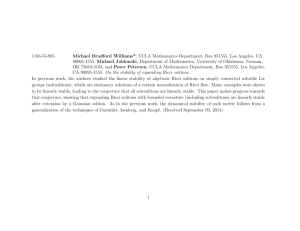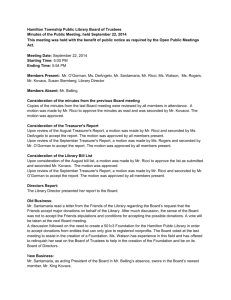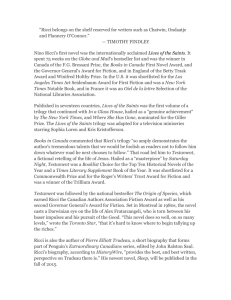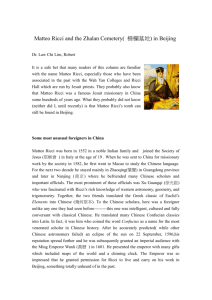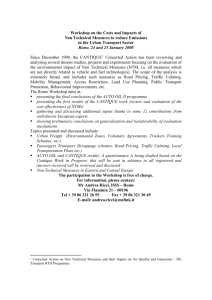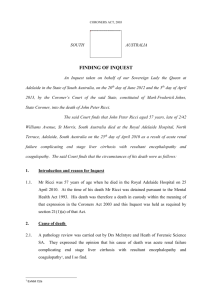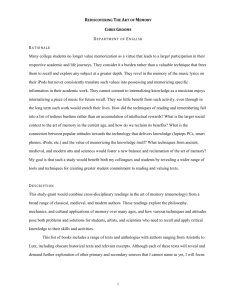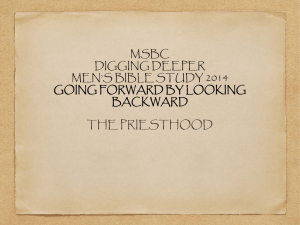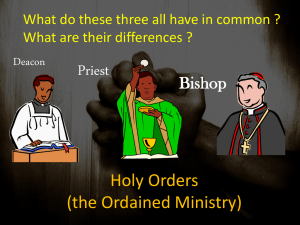THE EXTRAORDINARY EXPERIENCE OF PRIESTHOOD OF
advertisement
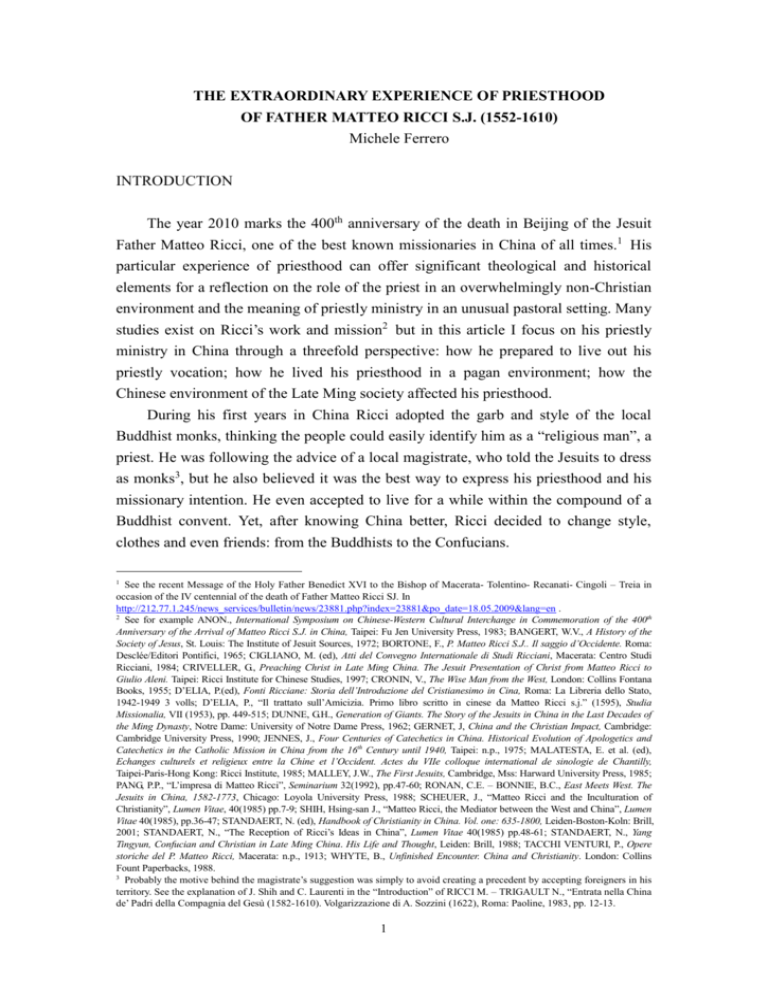
THE EXTRAORDINARY EXPERIENCE OF PRIESTHOOD OF FATHER MATTEO RICCI S.J. (1552-1610) Michele Ferrero INTRODUCTION The year 2010 marks the 400th anniversary of the death in Beijing of the Jesuit Father Matteo Ricci, one of the best known missionaries in China of all times.1 His particular experience of priesthood can offer significant theological and historical elements for a reflection on the role of the priest in an overwhelmingly non-Christian environment and the meaning of priestly ministry in an unusual pastoral setting. Many studies exist on Ricci’s work and mission2 but in this article I focus on his priestly ministry in China through a threefold perspective: how he prepared to live out his priestly vocation; how he lived his priesthood in a pagan environment; how the Chinese environment of the Late Ming society affected his priesthood. During his first years in China Ricci adopted the garb and style of the local Buddhist monks, thinking the people could easily identify him as a “religious man”, a priest. He was following the advice of a local magistrate, who told the Jesuits to dress as monks3, but he also believed it was the best way to express his priesthood and his missionary intention. He even accepted to live for a while within the compound of a Buddhist convent. Yet, after knowing China better, Ricci decided to change style, clothes and even friends: from the Buddhists to the Confucians. See the recent Message of the Holy Father Benedict XVI to the Bishop of Macerata- Tolentino- Recanati- Cingoli – Treia in occasion of the IV centennial of the death of Father Matteo Ricci SJ. In http://212.77.1.245/news_services/bulletin/news/23881.php?index=23881&po_date=18.05.2009&lang=en . 2 See for example ANON., International Symposium on Chinese-Western Cultural Interchange in Commemoration of the 400th Anniversary of the Arrival of Matteo Ricci S.J. in China, Taipei: Fu Jen University Press, 1983; BANGERT, W.V., A History of the Society of Jesus, St. Louis: The Institute of Jesuit Sources, 1972; BORTONE, F., P. Matteo Ricci S.J.. Il saggio d’Occidente. Roma: Desclée/Editori Pontifici, 1965; CIGLIANO, M. (ed), Atti del Convegno Internationale di Studi Ricciani, Macerata: Centro Studi Ricciani, 1984; CRIVELLER, G., Preaching Christ in Late Ming China. The Jesuit Presentation of Christ from Matteo Ricci to Giulio Aleni. Taipei: Ricci Institute for Chinese Studies, 1997; CRONIN, V., The Wise Man from the West, London: Collins Fontana Books, 1955; D’ELIA, P.(ed), Fonti Ricciane: Storia dell’Introduzione del Cristianesimo in Cina, Roma: La Libreria dello Stato, 1942-1949 3 volls; D’ELIA, P., “Il trattato sull’Amicizia. Primo libro scritto in cinese da Matteo Ricci s.j.” (1595), Studia Missionalia, VII (1953), pp. 449-515; DUNNE, G.H., Generation of Giants. The Story of the Jesuits in China in the Last Decades of the Ming Dynasty, Notre Dame: University of Notre Dame Press, 1962; GERNET, J, China and the Christian Impact, Cambridge: Cambridge University Press, 1990; JENNES, J., Four Centuries of Catechetics in China. Historical Evolution of Apologetics and Catechetics in the Catholic Mission in China from the 16th Century until 1940, Taipei: n.p., 1975; MALATESTA, E. et al. (ed), Echanges culturels et religieux entre la Chine et l’Occident. Actes du VIIe colloque international de sinologie de Chantilly, Taipei-Paris-Hong Kong: Ricci Institute, 1985; MALLEY, J.W., The First Jesuits, Cambridge, Mss: Harward University Press, 1985; PANG, P.P., “L’impresa di Matteo Ricci”, Seminarium 32(1992), pp.47-60; RONAN, C.E. – BONNIE, B.C., East Meets West. The Jesuits in China, 1582-1773, Chicago: Loyola University Press, 1988; SCHEUER, J., “Matteo Ricci and the Inculturation of Christianity”, Lumen Vitae, 40(1985) pp.7-9; SHIH, Hsing-san J., “Matteo Ricci, the Mediator between the West and China”, Lumen Vitae 40(1985), pp.36-47; STANDAERT, N. (ed), Handbook of Christianity in China. Vol. one: 635-1800, Leiden-Boston-Koln: Brill, 2001; STANDAERT, N., “The Reception of Ricci’s Ideas in China”, Lumen Vitae 40(1985) pp.48-61; STANDAERT, N., Yang Tingyun, Confucian and Christian in Late Ming China. His Life and Thought, Leiden: Brill, 1988; TACCHI VENTURI, P., Opere storiche del P. Matteo Ricci, Macerata: n.p., 1913; WHYTE, B., Unfinished Encounter. China and Christianity. London: Collins Fount Paperbacks, 1988. 3 Probably the motive behind the magistrate’s suggestion was simply to avoid creating a precedent by accepting foreigners in his territory. See the explanation of J. Shih and C. Laurenti in the “Introduction” of RICCI M. – TRIGAULT N., “Entrata nella China de’ Padri della Compagnia del Gesù (1582-1610). Volgarizzazione di A. Sozzini (1622), Roma: Paoline, 1983, pp. 12-13. 1 1 One of Ricci’s biographers, Daniello Bartoli, in 1663, explaining the way of life of the Buddhist monks, depicted with a strong language the reasons for this change: “These monks are the Religious and Priests of the idols sect in China and they are a dirty and vile gang, rightly despised by the Literati and kept in little or none account by the people. It was suitable that the Priests and Teachers of the Christian Law would behave completely differently from them”.4 The occasion for a change came from Father Lazzero Cattanei, a Jesuit who arrived in China on May 1594. Cattanei was instrumental in deciding to change attire and style from the Buddhists to the Confucian Literati because, although a new comer, he saw beyond the apparent similarities. “They [the Buddhists] seem to live like our monks – he writes – since the live and pray (“salmeggiano”) in common and do not have wives, but actually they are a nasty lot (“perversa canaglia”), the scum of the people (“feccia del popolo”) and to be a monk means to be evil (“scellerato”).5 Changing from Buddhist style to Confucian meant more than simply changing habit. Ricci began a new way of being a priest. Rather than concentrating on ritual practices and external performances of prayers in exchange for money, like the Buddhist monks, he concentrated on teaching, studying and debating doctrines with friends. He lived his priesthood in an unusual and extraordinary way, not always well understood even by his fellow Jesuits in the following centuries.6 In those same years also in Europe the challenge of Luther and the Reformers had forced the Church to rethink the meaning of priesthood as something more than ritual practices and external performances of prayers in exchange for money. This is not the problem of priests today. Yet the temptation of a “magical” use of the priesthood that appeals more to the natural religious sense of the people than to the fidelity to the Gospel is never completely won. Ricci could have played the card of religious superstition, exploiting Chinese traditions and habits towards fate and luck. Yet he chose faith over fate, and walked a path of fidelity to the words and example of Jesus, being a priest who is most of all a good teacher and a close friend. In this article I aim to show that this Ricci’s experience of priesthood can offer pastoral and theological insights about ministerial priesthood also for today. The presentation is divided as follow. First, a brief history of Ricci’s missionary work and theological formation. Second the munus of priestly teaching as lived by Ricci. Third the Chinese/Confucian influence on his priesthood. “Essendo i Religiosi e i Sacerdoti degli idoli colà nella Cina una fangosa e vil marmaglia, degnamente avuta in dispregio da’ Letterati, e in poco o niuno rispetto al volgo, conveniva, che dei Sacerdoti e Maestri della Legge cristiana giudicassero tutto altramenti che di que’ della loro”. BARTOLI, Daniello, Dell’istoria della compagnia dei Gesù. La Cina, terza parte dell’Asia, Ancona: Aureli, 1843, in 4 volls, vol. 1, p 346. 5 BARTOLI, op. cit., vol 2, p. 21. See also vol. 4, p.751 6 BROCKEY, L. M., Journey to the East. The Jesuit mission to China 1579 – 1724, Cambridge MSS: The Belknap Press of Harvard Univ. Press, 2007, p. 182. 4 2 THE FORMATION OF FATHER MATTEO RICCI AND ITS SIGNIFICANCE FOR HIS MISSIONARY PRIESTHOOD IN CHINA What elements of Ricci’s formation played a greater role in his priestly ministry? Matteo Ricci was born in Macerata, Italy, in 1552. He attended the newly opened Jesuit school of the town from 1561 to 1565. In 1571, on the day of the feast of Assumption, Ricci asked to join the Jesuit order. At that time the Society of Jesus was growing impressively fast, both in number and in reputation, after the official recognition as a religious order of the year 1540, with the papal bull Regimini Militantis Ecclesiae. After the studies in Italy, Ricci continued his formation in Goa, India, where was ordained as a priest. He then arrived in China, at Macao, in 1582. Together with a few companions he entered Mainland China and lived for some years in the Southern province of Canton, establishing a Jesuit house in Shaocheo, (1583-1589). From there he moved to Nanjing and Nanchang, becoming friend of local scholars and government officials (1589-1598). Finally he settled in Beijing, entering the world of the Ming imperial court as mathematician and astronomer (1595-1610). Ricci died in Beijing on May, 10th, 1610 and was buried there. His priesthood was affected both by his own formation in Italy and by the Chinese environment where he lived for 30 years. All the Philosophical and Theological formation of Matteo Ricci, from 1571, the year of his Noviciate, until 1582, the year of his Ordination, took place during the height of the so-called “Thomistic Renaissance” of the XVI century. He spent one year of Novitiate in Rome, where Fr. Fabio de’ Fabi was his novice master.7 He was then chosen, together with 50 other companions, to go for one year to Florence. The number of the Jesuits at the time was a little over 50008, yet it seems the Divine Providence never wanted Ricci too far away from the arts and the culture of the Renaissance. During his previous few years at La Sapienza University Ricci had studied Law, but now, as a Jesuit student, it was time to go back to Letters and Arts in preparation for Philosophy. While in Florence he attended classes of Rhetoric under the guidance of Martino Fornari.9 Toward the end of 1573 Ricci went back to Rome, where he spent the following four years at the Roman College, the school of the Jesuits par excellence (later called Università Gregoriana). St. Ignatius had founded the Roman College in 1551 to be the center of Jesuit theological and philosophical formation. The Faculty of Philosophy and Theology opened in 1553. In the school year 1574-1575, together with Ricci, there were 230 students of philosophy, 200 of theology, and around 600 in 7 8 9 RICCI, M., Le lettere dalla Cina (1580-1610), Macerata: Giorgetti, 1913, p.124, my translation. Ibidem. FOIS, M., “Il Collegio Romano ai tempi degli studi del P. Matteo Ricci”, in CIGLIANO, M., Atti del Convegno Internazionale di Studi Ricciani, Macerata: Centro Studi Ricciani, 1984, p.216. 3 the school of letters.10 The religious fervor, even more than the teaching methods, was one of the main reasons for the fame of the school.11 In the first two years (1573-75), Ricci continued the study of Retorica, (rhetoric), during which the students were formed to be vir catholicus dicendi peritus.12 During these years of Rhetoric Ricci studied Latin and Greek classical authors, but probably not Hebrew, which was only for students of theology.13 The main texts were Cicero’s Discorses, the De Oratore, the Partitiones oratoriae for Latin, and Demostenes and Homer for Greek. At the time of the first Ratio Studiorum (1570) Lucanus, Statius and the tragedies of Seneca were still accepted. It is therefore likely that in 1574 Ricci studied them, although these authors will not appear in later editions of the Ratio, where the perfect model of oratory will be only Cicero. The classes of Rhetoric aimed at achieving a perfect use of Latin and Greek, therefore only the best authors of those languages were taken up by the students. All the Christian authors (the “Fathers of the Church”) were not taken into account, since their Latin and Greek was not considered as “pure” as that of the classics. This prejudice continued until the twentieth century.14 He also studied Philosophy at the Roman College between 1575 and 1577, where, since 1564, the prefect of studies was the Spanish Francisco de Toledo (1532-1596), one of the leading figures in the revival of Aristotelism in the XVI century. Moved by the Spirit and by the environment, Matteo Ricci presented his request to be sent to the missions in 1576, it was soon accepted, and on November 1577 he went to the Northern Italian port of Genoa, from where he sailed to Lisbon and then to Goa. According to the Ratio Studiorum of the Jesuits, also in Goa, like in Rome and in all other Jesuit Institutes of higher education, during the years of Philosophy, the students had to study mainly Aristotle. The philosophy course was then followed by theology, especially Moral, in which the principles of morality and how to apply them to each case were studied. 15 Following the explicit instructions of Ignatius, the foundations of theological studies were the Old and New Testament and St. Thomas Aquinas.16 In 1580 Ricci, despite two attacks of a disease,17 was ordained priest by Matteo De Medina bishop of Cochin. How much theology did Ricci manage to study in Goa? And which authors were used? Under which theological influence did Ricci mature his formation? A revival of 10 11 12 13 14 15 16 17 BORTONE, F., P. Matteo Ricci S.J.. Il saggio d’Occidente. Roma: Desclée/Editori Pontifici, 1965, p.38. See VILLOSLADA, R.G., Storia del Collegio Romano. Dal suo inizio (1551) alla soppressione della Compagnia di Gesù (1773) Analecta Gregoriana, LXVI, Series Facultatis Historiae Ecclesiasticae. Rome: Apud Aedes Universitatis Gregorianae, 1954, p.116. “Catholic men expert in arts”, after the original classical vir bonus dicendi peritus of Cicero. See FOIS, op. cit., p. 217. VILLOSLADA, op. cit., p.89. See FERRERO, M., “Dalla Selecta ex Christianis Latinis Scriptoribus di don Bosco alla Corona Patrum della SEI”, in PROVERBIO, G., Dum Docent Discunt. Per una didattica delle lingue classiche, Bologna: Patron Editore, 2000. AMALADASS, A. (ed.), Jesuit Presence in Indian History. Commemorative Volume on the Occasion of the 150th Anniversary of the New Madurai Mission 1838-1988. (Anand: Gujarat Salitya Prakash, 1988), esp. p.69. BEA, A., “La Compagnia di Gesú e gli studi biblici”, p.123, in ANON., La Compagnia di Gesú e le Scienze Sacre. op. cit. Probably malaria. See BORTONE, op. cit., p.82. 4 Scholasticism had been the answer of Trent to the challenge of Luther, and “it stamped its character on the era”18, also in Asia. In the second half of the XVI century, in Europe, theological debate was flourishing. However, how much the “golden age of Scholasticism” enriched the minds of the students of Indian Goa is hard to say. Surely by the time Ricci arrived in Goa, Thomas Aquinas had fully replaced Peter Lombard as the main author for theological lessons. Ignatius thought that Thomas Aquinas was the author most suitable for the needs of the students in those times of doctrinal turmoil, and he recommended that St. Thomas’s works, especially the Summa Theologiae, should be employed in the classes of theology.19 This was an act of “courage and originality.” 20 The first complete commentary of the Prima Secundae was written by Conrad Koellin (1476-1536). Yet the theologians, who probably gave the greatest contribution to the revitalization of Thomistic Scholasticism, were Francisco de Vitoria (1480-1546) and Cardinal Cajetan Thomas De Vio’s (1469-1534), author of commentaries on, and defense of, Thomas’s works, especially De Ente et essentia and the Summa Theologiae. These were certainly authors whose works Matteo Ricci studied during his theological formation. Another important author of the time was Melchior Cano (1509-1560). Cano’s main theological work is De locis theologicis, published posthumously in 1563, and was reprinted many times. He argues that theology is first of all a “science from authority”, having as its source the Bible, the authorities of the Church, the traditions of the saints and of the Councils. Reason, philosophers, jurists and history have a secondary position in the elaboration of doctrine. It can be noticed that the importance attributed by Cano to Tradition in theology and philosophy is more similar to the way of thinking of the Confucians, who value “tradition” than to the Cartesian foundation of philosophy on clear and distinct ideas. Other authors of the time whose writings might have indirectly influenced the theological formation of Ricci were Medina, Soto,21 Banez,22 Seripando,23 De Valencia.24 So the elements of Ricci’s formation were: 1) solid philosophical foundation (Aristotle, Plato, Cicero) 2) openness to science and art (Renaissance) 3) rigorous Thomism 4) a great spirit of prayer 5) strong solidarity within the Jesuit order 18 JEDIN, H., History of the Church. Reformation and Counter Reformation, New York: The Seabury Press, 1980, p.535. GANSS, G., St. Ignatius’s Idea of a Jesuit University, Milwaukee: The Marquette University Press, 1954, p.159. 20 Idem, p.158. 21 Dominic (or Domingo) Soto (1494-1560) was chosen by the Emperor Charles V as one of the imperial theologians at the Council of Trent. In 1550 he returned to Salamanca, where he succeeded Cano to the chair of theology. Among his most important works is a manual of logic, called Summula, a treatise on nature, grace and original sin, De Natura et Gratia; and the Sententiae, a compendium of theology and philosophy. 22 Dominic (or Domingo) Banez (or Vanez) (1528-1604) was the spiritual director and confessor of St. Therese of Avila. He promotes a strong emphasis on Thomism and Scholasticism. He was involved in the dispute De auxiliis. 23 Girolamo Seripando (1492-1563), one of the few Thomists neither Spanish or Dominican, during the Council of Trent proposed to elevate Scripture above Tradition as the source of Catholic truth, but he failed. However he was influential in formulating the final decrees on justification and original sin. 24 Gregory of (“de”) Valencia (1549-1603). In 1598 was called to Rome as Prefect of Studies at the Roman College and in 1600 had the task of defending the theses of Molina in front of Pope Clement VII and the Cardinals. 19 5 RICCI’S PRIESTHOOD IN MING CHINA: THE MUNUS OF TEACHING The three munera of a priest are to teach, to govern and to sanctify. “Priests by sacred ordination and mission which they receive from the bishops are promoted to the service of Christ the Teacher, Priest and King” (PO 1). During the preparation of the document on priesthood there were discussions among the Fathers of the Second Vatican Council on whether any of the three munera has priority25. At the end, the Council stated simply: “priests, as co-workers with their bishops, have the primary duty of proclaiming the Gospel of God to all” (PO 4). Paul VI in his magisterium simply insists that “primarily and immediately the mandate of Christ to preach the Gospel to every creature pertains to bishops and priests as their associated”26. His successor “John Paul II strongly emphasizes the missionary dimension of priestly ministry”27. Avery Dulles in his The priestly office 28 presents the position of the three greatest theologians of the XX century on this issue. For Rahner the ministry of “preaching” in the ordained minister comes before “leadership”. Dulles comments by asking whether this idea comes from a priest-professor who teaches in a classoom rather running the administration of a parish. “Rahner is rather vague on the pastoral responsibilities proper to the presbyter. Perhaps that is because as a religious priest he was generally free from parochial duties”29. Balthasar was another professor. “Like Rahner, Balthasar sees the ministries of sacramental worship and pastoral government as implied in, and deriving from, the authoritative ministry of the Word”30. Also according to D. Power for Balthasar the priest is first of all a teacher and a prophet and there is a definite and clear sense of the primacy and authority of the Word of God in the life of the priests.31 Ratzinger is the third representative of the “Word-centered concept of priesthood”. “In several articles published in the late 1960’ Ratzinger continued to emphasize the primacy of the Word in priestly ministry”32. Indeed everybody would agree with Dulles that the proclamation has a temporal priority. “The ministry of the word holds a certain priority among the task of the priest because unless the faith is proclaimed and received, none of the other activities of the church makes any sense”33. For Ricci the main way of exercising his priesthood was precisely by teaching and preaching. Facing the challenging task of building a See for example ALBERIGO, G., (ed.), Storia del Concilio Vaticano II. Vol 4. La Chiesa come comunione settembre 1964 – settembre 1965, Bologna: Il Mulino, 1999, pp. 598 – 605. 26 Idem, p 23. 27 Idem, p 25. 28 DULLES, A., The priestly office. A theological reflection, New York: Paulist Press, 1997. 29 Idem, p. 20 30 Idem, p. 21 31 POWER, D., A spiritual theology of the priesthood, Washington: The Catholic University of America, 1998, pp. 121-124. 32 DULLES, op. cit., p. 22 33 DULLES, op. cit., p. 29 25 6 Christian community from nothing, the first and main duty of Ricci could not have been to be Priest and King, at least in the sense of administering Sacraments or governing the Church. Surely he baptized people, including some famous government officers of the time (Xu Guangqi, Li Zhizao, Yang Tingyun34), and he governed, being the responsible for his community of fellow Jesuits in China. Yet his main and most striking way of being a priest was through preaching and teaching. When applied to the munus of a priest, “teacher” is referred primarily to the teaching of sacred truths. There are many ways to do it, as the Council reminds. “And so, whether by entering into profitable dialogue they bring people to the worship of God, whether by openly preaching they proclaim the mystery of Christ, or whether in the light of Christ they treat contemporary problems, they are relying not on their own wisdom for it is the word of Christ they teach, and it is to conversion and holiness that they exhort all men. But priestly preaching is often very difficult in the circumstances of the modern world. In order that it might more effectively move men's minds, the word of God ought not to be explained in a general and abstract way, but rather by applying the lasting truth of the Gospel to the particular circumstances of life.” (PO 4) At the end of his life Pope John Paul II wrote: “In these 50 years of priestly life I realized that Redemption, the price paid for sin, brings about also a renewed discovery, almost a new Creation, of everything created: the rediscovery of men as persons, man created by God as man and woman, the rediscovery, in their deepest truths, of all the works of man, his culture, his civilization, all his endeavors and creative activities”35. This primary duty of bringing about a rediscovery of created realities in the light of Redemption is an urgent duty for any priest, today as in the past. Priests always risk to be confined in the sacristies or in the presbytery, to be “the man of the sacred” in the negative sense of being far away from the people or in the sense of working exclusively for those who are already Christians. The world, in its negative Johannine sense, strives to keep priests out of the human society, through endless sophisms and subtle persuasions. It is a recurring temptation for a priest to limit his action within the borders of the Church. In the article “Verso un istituto missionario di sacerdoti secolari”, J. Metzler tells the story of the failed attempt of a “fidei donum” project ante-litteram as early as 1622, shortly after the death of Matteo Ricci. One of the prelates of Propaganda Fide, Fr Vives, wrote to the Holy Father lamenting that the secular clergy had practically abandoned the missionary ministry36 and the project could be a way to revive the See: BROCKEY, L. M., Journey to the East. The Jesuit mission to China 1579 – 1724, Cambridge MSS: The Belknap Press of Harvard Univ. Press, 2007, esp. p. 59. 35 GIOVANNI PAOLO II, Dono e mistero. Nel 50 del mio sacerdozio, Città del Vaticano: Libreria editrice vaticana, 1996, p. 92, my translation and my italics. 36 “I sacerdoti secolari hanno quasi completamente abbandonato il ministero missionario”, see: AA.VV., Sacra Congregationis de propaganda fide memoria rerum. 1622-1972, Rome – Freiburg – Wien: Herder., vol 1, p 507. 34 7 flame. The same worry appears centuries later in Pius XII’s Fidei donum and in John Paul II’s Redemptoris Missio.37 Priests need to rekindle their intrinsic missionary vocation, the announcement of the Gospel to non-believers. Heralding the coming of the Kingdom to the world cannot be done staying outside the world. While the munus of sanctifying and governing are addressed eminently to believers, the duty of teaching brings the priest in touch with everybody. Every human being has been created with a natural desire to know the truth38 and teaching is a formidable instrument of evangelization for a priest. Looking in detail at the munus of teaching in Father Matteo Ricci, we see three characteristics. First it was a very special cura animarum. Second, it was based on friendship. Third, it aimed at scientific excellence as a means both to dialogue and to get public recognition. First it was a very special cura animarum. One of the topics of conversation most used by Ricci and his companions to introduce the readers or hearers to the mystery of faith was the substance, the origin and the destiny of the human soul. In his theological masterpiece, The True Meaning of the Lord of Heaven39, Ricci devotes two chapters to discuss with a Chinese scholar about the soul. Buddhism and Taoism have rich theories about the soul, ranging from “reincarnation” to “organic unity” with the universe, from the soul as “energy” to the presence of soul in animals.40 Many of Ricci’s Confucian friends were interested in the topic, also in connection with the cultivation of virtue and the issue of the goodness of human nature. Ricci’s teaching and approach is twofold. On one side he relies heavily on his own Aristotelian-Thomist studies, with the distinction substance/accident; matter/form; the threefold division of the soul in vegetative, sensitive and rational and the question of soul’s immortality. On the other side he touches the soul of his hearers with something that goes beyond intellectual proofs. His exemplary life and his priestly concern for the souls was something new in the world of philosophers, scholars and government officials. Many Chinese intellectuals were used to debate “soul” but nobody has ever met someone who would really care for theirs. Da mihi animas, coetera tolle, (“give me the souls, take away the rest”) used to say don Bosco. And John Paul II says “Only from the ground of priestly holiness an efficacious pastoral “Nothing is so inconsistent with the Church of Jesus Christ as division; nothing is so opposed to her very life as for her members to take refuge in selfish solitude, or to be too much devoted to themselves and to take an interest only in the private concerns of their own little group. Such an attitude surely causes any particular Christian community to become completely self-centered”. POPE PIUS XII, Encyclical Letter Fidei Donum On the Present Condition of the Catholic Missions, Especially in Africa, 1957, n. 45. “Nevertheless, in this "new springtime" of Christianity there is an undeniable negative tendency, and the present document is meant to help overcome it. Missionary activity specifically directed "to the nations" (ad gentes) appears to be waning” POPE JOHN PAUL II, Encyclical Letter Redemptoris Missio On the permanent validity of the Church's missionary mandate, 1990, n. 2. 38 POPE JOHN PAUL II, Fides et Ratio, n. 1. 39 RICCI, M., The True Meaning of the Lord of Heaven. Translated, with introduction and notes by D. LANCASHIRE and HU KUO-CHEN and edited by E.J. MALATESTA, Taipei-Paris-Hong Kong: Ricci Institute, 1985. 40 FERRERO, M., The cultivation of virtue in Matteo Ricci’s “The True Meaning of the Lord of Heaven”, Taipei: Fu Jen Catholic University Press, 2004. 37 8 and a real cura animarum can grow”41. This was the road walked by Ricci to exercise his priestly teaching among Chinese non Christians. Second. His teaching was based on friendship. One of his most successful books was a Chinese translation of sentences on friendship from classical Latin and Christian authors, by the Chinese title “On Friendship”. He lived what he translated.42 He tried to be friend of the people he met, not in view of gaining something but simply out of inner Christian charity. Disinterested friendship is the best social charity, and one of its rarest forms. However, the ministry of the Word, unlike the ministry of the Sacraments, depends largely on the holiness and preparation of the minister. “In the administration of the sacraments this guarantee is assured to the extent that not even the sinful condition of a minister can impede the fruit of grace. There are many other acts in which the human qualities of the minister acquire notable importance. Those qualities can serve to promote or impede the apostolic effectiveness of Church. While the entire munus pastorale must be characterized by service, it is especially necessary that service characterize the minister of preaching since the salvific effectiveness of the Word becomes more operative when its minister, who is never master of the Word, increasingly becomes its servant.”43 In a sermon preached in 1832, John Henry Newman beautifully presented personal influence as a means of propagating the truth. “The men commonly held in popular estimation are greatest at a distance; they become small as they are approached; but the attraction, exerted by unconscious holiness, is of an urgent and irresistible nature; it persuades the weak, the timid, the wavering, and the inquiring; it draws forth the affection and loyalty of all who are in a measure like-minded…”44 This is the case of Ricci. His priesthood as ministry of the Word passed through a personal effort at real human friendship. We can compare with don Bosco’s words, centuries later: “If a teacher is seen only at his teaching desk is nothing more than a teacher, but when he stays among the young, he is seen as a friend.” Third. The teaching of Ricci aimed at scientific excellence. The issue of the “inculturation” of his priesthood meant dialogue with sciences: Natural Sciences; Astronomy; Matemathics; Mnemonic.45 The interest of Ricci for sciences was not simply a tool to gain access to the imperial court. It was a real part of his priesthood as well as a characteristic of the Jesuit tradition. J. O' Donnell and S. Rendina, 41 GIOVANNI PAOLO II, Dono e mistero, op. cit., p 101, my translation. As mentioned also by Pope Benedict XVI in the message quoted above. 43 CONGREGATION FOR THE CLERGY “The priest and the third Christian Millennium. Teacher of the Word, minister of the Sacraments and leader of the community” Vatican City, 19 March 1999; Website: http://www.vatican.va/roman_curia/congregations/cclergy/documents/rc_con_cclergy_doc_19031999_pretres_en.html, accessed on May 25, 2009. 44 NEWMAN, J.H., Newman’s University Sermons. Fifteen sermons preached before the university of Oxford 1826-1843, London: SPCK, 1970, p. 95. 45 Ricci wrote a treatise on Mnemonic (“The memory palace”), the art of remembering. He himself had a prodigious memory. 42 9 presenting priesthood and Ignatian spirituality46, inquiry on why Ignatius felt that his order had to be made up of priests. The answer is that for Ignatius the priest is first of all a man totally dedicated to God and moreover the priest is a preacher authorized and sent by the hierarchical church.47 Dedication to God and being sent by the hierarchy are the characteristics of a teacher-priest. J. O' Donnell and S. Rendina mention in particular Matteo Ricci as an exemplary solution to the problem of professionalism/secularization in connection with priesthood. The principle is: “faithful to the sacerdotal finality of the congregation”.48 During his study of philosophy (1575-77) Ricci had learnt how to dispute on philosophical problems using a new, yet old, powerful weapon: the dialectic of Aristotle. Aristotle was the standard of learning for every institute of higher education.49 The Ratio Studiorum of the Jesuits, quoting a canon from the IV Lateran Council, had already clearly stated that in Logic and in Natural and Moral Philosophy and in Metaphysics the doctrine of Aristotle had to be used.50 At the time of Ricci, Aristotle was studied both through his own works and with the help of some manuals, such as Francesco Toledo’s Introductio in dialecticam Aristotelis (1561) and Commentaria in universam Aristotelis logicam (1572), and Pietro de Fonseca’s Institutionum dialecticarum libri octo (1564).51 In those times, mathematics, astronomy and geometry were also compulsory classes for the Jesuits students of the Roman College. Euclide’s Mathematica was the main text of study.52 Fr. Cristoforo Clavio was among the teachers of Ricci, as he himself reminds his readers in his History of the Introduction of Christianity in China.53 The Roman College’s emphasis on mathematics and science was a way to cope with the growing scientific development of the Renaissance, which seemed at time to threaten the foundation of faith. The goal of St. Ignatius was to form pastors for a changing society. But then it happened that, especially in China, science unexpectedly became one of the best pastoral methods.54 Chinese culture has always been fascinated by scientific progress. The ancient emperors were praised more for their ability in building dams and roads and channels O’ DONNEL, J. – RENDINA, S., Sacerdozio e spiritualità ignaziana, Roma: Pontificia Università Gregoriana, 1993, p. 191. Idem, pp 89 – 108. 48 Idem, p. 141. 49 FOIS, op. cit., p.218. 50 In logica et philosophia naturali et morali at in metaphysica doctrinam Aristotelis profiteri oportet, as in the Fourth Part of St. Ignatius’ Constitutions of the Society of Jesus, chapt.14, n.3. See also FOIS, op. cit. p.218. 51 Published in Coimbra, and so known as Conimbricensis, see GALTIER P., La Compagnia di Gesù e la Teologia Dommatica, in ANON., La Compagnia di Gesù e le Scienze Sacre, Analecta Gregoriana Series Theologica, XXIX, A(3), Rome, 1942. Da Fonseca was also known as the “Portoguese Aristotelis” See also VILLOSLADA, R.G., Storia del Collegio Romano. Dal suo inizio (1551) alla soppressione della Compagnia di Gesù (1773), Analecta Gregoriana, LXVI, Series Facultatis Historiae Ecclesiasticae. Apud Aedes Universitatis Gregorianae Rome, 1954, p.102. 52 VILLOSLADA, op. cit., p.102. 53 See D’ELIA, P., Fonti Ricciane: Storia dell’Introduzione del Cristianesimo in Cina, Roma: n.p.1942-1949, n.262. 54 About this topic see also KOLVENBACH, P.H., S.J., “Johan Adam Schall von Bell – a Jesuit”, in MALEK, R., S.V.D., Western Learning and Christianity in China. The Contribution and Impact of Johan Adam Schall von Bell S..J. (1592-1666), Monumenta Serica Monograph Series XXXV/2, St. Augustin: China Zentrum/Monumente Serica Institute, 1998, p.37. 46 47 10 than for their philosophy. Many of the contemporary Chinese leaders come from a background on engineering or science. Why Communism was easily accepted in China? Also because it found a fertile ground when talking about progress, development, scientific advancement. It is not a coincidence that one of the 20th century Jesuit theologians who wrote significant works on the relation between Revelation and science did it during his staying in China. Pierre Teilhard de Chardin lived in China from 1923 to 194655, working on stratigraphy and paleontology. There he developed his theological vision, presented in his The Phenomenon of Man (1959).56 For both Ricci and Teilhard de Chardin there is no opposition between being a priest and being open to progress and science.57 Some of Teilhard’s intuitions found their way in Gaudium et Spes.58 Like Ricci, he believed in science and progress as instruments of love. “Too many Christians are not aware of their divine responsibility, working only half-heartily, without feeling the excitement of bringing the Kingdom of God in any area of human life (…) We have the right and the duty, in name of our faith, to feel passionately about the things of the human world.”59 This does not mean to “look at the things of the world instead of looking at the things of Heaven” (Col 3,1). It means rather a deep real love for fellow human beings and a sincere interest in what concern their daily lives. Ricci lived this Christian teaching, expressed centuries later by the Second Vatican Council: “Nothing that is genuinely human fails to find an echo in the hearts of Christians. (…) Christians cherish a feeling of deep solidarity with the human race and its history” (GS 1). As don Bosco used to say: “Love what the young people love”. “Applying the lasting truth of the Gospel to the particular circumstances of life” (PO 4) means that by his teaching ministry the priest leads others to the discovery and appreciation of created realities, and from here to the Creator, and his Incarnation and the history of salvation of which we all are part. “The Kingdom of God is among you” (Lc 17,20). The issue of how far a priest can go in his involvement in earthly matters must here be touched, albeit briefly. In a book on priesthood Jean Galot debates the issue of “secular occupations” for the priest, referring in particular to the “factory priest” of the ’60 and ’70 but then expanding the question: “when is the exercise of a secular occupation appropriate for priests today?” One of his answers is: “as a means to exercise an apostolate”.60 Indeed for Ricci, as for thousands of Jesuits and Salesians “Teilhard de Chardin”, in New Catholic Encyclopedia, New York and other cities: McGraw-Hill Book Co, 1967, pp. 976-978 See for example: TEILHARD DE CHARDIN, Il sacerdote, Brescia: Opera Sacerdotale, 1965; L’ARCO, A., Messaggio di Teilhard de Chardin. Intuizioni e idee madri, Torino: LDC, 1964; SMULDERS, P., The design of Teilhard de Chardin. An essay in theological reflection, Newman Press: Westminster, MA, 1967. 57 For the “official atheists”, De Chardin was the “public enemy n. 1”, see TEILHARD DE CHARDIN, Il sacerdote, Brescia: Opera Sacerdotale, 1965, p. 43, note 6. 58 ARDUSSO, F. and others, La teologia contemporanea, Torino: Marietti, 1980, p.374. 59 TEILHARD DE CHARDIN, P., “L’ambiente divino”, quoted in Ardusso, La teologia contemporanea, op. cit., 1980, p.388. 60 GALOT, J., Theology of the priesthood, San Francisco: Ignatius Press, 2005, p. 224. 55 56 11 along the centuries, priestly apostolate was done through the daily task of teaching, including teaching Mathematics, Physics, Latin or Engineering. It was not only a means, a tool, a device for apostolate. It was part of the openness to the truth and goodness that is the distinctive sign of every Christian and of every priest (GS 15). Science itself, as natural knowledge, cannot lead to God. “Infelix enim homo qui scit omnia te autem nescit; beatus autem qui te scit, etiamsi illa nesciat” (Augustine, Confessions, 5.4.7). The greatest science is the fear of God. Timor Dei is the beginning of wisdom. To be able to speak all languages without love is nothing (I Cor 13). “The highest science is faith and love” (S. Mary Dominic Mazzarello). Yet Father Matteo Ricci handled with the priestly munus of teaching any scientific subject, transforming everything in the light of the Redemption. Teaching is part of the search for the “splendor of truth”, that can lead to the meeting with God in Jesus Christ. “Thanks to meetings and discussions with naturalists, physics, biologists and even historians I learned to appreciate the importance of other areas of knowledge and scientific disciplines, to which is given to reach the truth though from different angles. It is necessary that the splendor of truth always accompany science, to allow men to meet, to exchange reflections and so to enrich each others”61. Benedict XVI writes in his “Caritas in Veritate”: “In view of the complexity of the issues, it is obvious that the various disciplines have to work together through an orderly interdisciplinary exchange. Charity does not exclude knowledge, but rather requires, promotes, and animates it from within” (CiV 30). This openness to science and teaching and learning is a particular characteristic of both Jesuit and Salesian priests. The excellence of Salesian priests-teachers was, and is, a trademark of many of our institutions, as it is for the Jesuits. CHINESE INFLUENCE ON RICCI’S PRIESTHOOD Finally: did China affect Ricci’s way of being a priest? Certainly it did. To begin with, the way he dressed was different from his contemporary priests in Europe. He dressed as a local Confucian scholar. Was it just an external change? In what other way did China influence his priesthood? Pope Benedict XVI once discussed the issue of the historical roots of Christianity in a speech at the University of Regensburg, on September 12th, 2006, (a speech unfortunately remembered only for a reference to Islam and the successive Muslim reaction). The Pope said that it is impossible a “de-Hellenization” of Christianity because this was the environment of the first Christians.62 The same happened in all centuries and in all places. Similarly, as 61 GIOVANNI PAOLO II, Dono e mistero, p. 105, my translation. “Ellenizzazione e disellenizzazione del messaggio cristiano”, CIVILTÀ CATTOLICA, Editoriale, n 3812, April 2009, pp.107-112. 62 12 Christianity grew in China, some kind of “Chinesization” became unavoidable. History and geography do affect the Church. The issue and the challenge is to harmonize historical and geographical influences with Christ’ s will and teaching63 and to see what can be good and useful for the universal Church. How did full immersion in Chinese culture affect Ricci’s priesthood? Is there anything the Church can learn today from his priestly experience in China? An answer can be attempted following three lines of inquiry. The first is linked with the birth of a Chinese Christian terminology. Ricci continued the work began by his confrere Michele Ruggieri: to express the truths of Christian faith in Chinese. The task was arduous. They began using transliteration: Chinese characters reproducing the sound of Latin words, but soon it appeared a nonsensical language to the readers. Then they adopted Buddhist vocabulary, with all the misunderstanding connected with a very different world-view and religion. Finally Ricci, perhaps advised by his new friends among the Confucian literati, some of whom newly converted, used Confucian terminology in his most famous and influential presentation of the Christian faith: The true meaning of the Lord of Heaven, published in Beijing in 1603. The influence of Confucianism in his works (especially the use of “仁” and “禮”) is a fascinating topic but too wide for this article. It is sufficient to give some examples. The translation of the word “Church” in Chinese is more connected with the Confucian idea of “teaching” than with the Greek verb “calling”. The word chosen by Ricci for “love” is not the same used by Buddhist for “compassion” but the one used by Confucians to express a “proper interpersonal relationship”. One of the Chinese words used to translate “liturgy” is used in the Confucian tradition to express “the rites” of proper interpersonal relationship. Ricci presents himself as a “Western scholar” rather than using the word employed by Buddhists or Taoists for “priest”. Thus the first influence of Chinese culture on Ricci’s priesthood was in the vocabulary chosen, with the Confucian emphasis on teaching and learning, relationship and hierarchy. Did this choice affect the Gospel message? Perhaps yes. Also in the Western world the passage from Greek to Latin sometimes caused heated theological controversies. (In China the theological debate was however limited). The second influence is in the Confucian idea that a person in always in relation. Everybody is always the son of some father, or the subject of some ruler, or the friend of some friend, or, in some cases, the brother of some brother or the husband of a wife. In the Confucian tradition there are five main relationships: husband/wife; father/son; ruler/subject; brother/brother; friend/friend. Ricci developed his priestly ministry not See for example the synthetic presentation of the historical development of priesthood in E. Niermann article’s “Priest”, in: RAHNER, K., (ed.), Encyclopedia of Theology. A Concise Sacramentum Mundi, London: Burns and Oates, pp. 1282-1285. See also GALOT, J, Theology of Priesthood, op. cit, where the author discusses the relation between “development of priesthood” and Scriptures and Tradition, Revelation and History. 63 13 so much as a father or a ruler but as a friend, as Pope Benedict XVI stressed in the quoted message on the occasion of the anniversary of his death.64 There is no identity without relationship. Confucian culture is all about building proper relationships. It is a useful reminder for today’s priests. Christian priesthood is always in relation: with Christ, with the Church, with the bishop, with the people. This area of inquiry could give theology new perspectives on the reflection on the relation between Trinity and priesthood, by adding to the classical ontological language and the modern phenomenological approach, also the element of Confucian relationship. Confucian tradition can offer new perspectives to the issue of “Petrine or Johannine/Marian” ministry. By this expression it is usually meant a spirituality of priesthood that refers to the theology of Balthasar. The Swiss theologians presented the Peter-John relationship as model of the Church. Peter represents the “office” while John, and Mary, represents “love” and “the spirit”. Both things are necessary. “Before they were placed into office, the whole Church was present in Mary”65. Who would represent “relationship”? Peter or John, or Mary? New ways can be opened to ecclesiology and the theology of priesthood by developing the Gospel teaching with the forma mentis of the Confucian philosophy of relationship. The third area of influence comes from the Confucian idea of “Li”, “rites”. Rites do not indicate external practices, but more deeply the ultimate sense of life, that is to be found in proper interpersonal relationship. Unfortunately the “right place in society” according to the Confucian tradition has been exploited along the centuries to divide society between classes. This was one of the reasons why Mao and the Communists attacked vehemently Confucianism during the Cultural Revolution. Yet its original meaning was a way to achieve harmony in society, not to exploit class differentiation. To be able to behave appropriately with any person is a wonderful ideal. For Confucius “rites” are not about “superiority” or “inferiority” but about “propriety in relationship”.66 Thus Jesus’ teaching on love, service, the last place, simplicity, can find a beautiful field of philosophical language in the Confucian tradition. What is the right place for a Christian in the world? What is the right place of a priest? The road towards a possible ideal of “Christian Confucian Rites” can pass through the example of Theresa of Lisieux: “I found the right place in the Church – and in the world. I will POPE BENEDICT XVI, Message of the Holy Father to the Bishop of Macerata- Tolentino- Recanati- Cingoli – Treia in occasion of the IV centennial of the death of Father Matteo Ricci S.J., op. cit. 65 POWER, D., A spiritual theology of the priesthood, Washington: The Catholic University of America, 1998, p. 60, quoting Von Balthasar. 66 See for example FINGARETTE, H., Confucius. The Secular as Sacred. New York: Harper and Row, 1972; CHANG, CH’I-YUN, Confucianism. A Modern Interpretation. Taipei: The Hwa Kang Press, China Academy, 1980; KAO, MING (Ed.), Confucianism and Chinese Culture. Taipei: National Institute for Compilation and Translation, 1987; LOKUANG, S., “Rapprochement between Modernized Confucian Thought and Christian Belief”, Ching Feng, 31/2-3 (1988), pp.152-165. 64 14 be love”. Or the powerful image of the Letter to Diognetus “Christians are like the soul of the world”. What is the right place of the priest? Jesus’ teaching is explicit: the washing of the feet (Jn 13); the last place (Mk 9,35); authority as service (Mt 20,25-26). The Apostles’ and the saints’ example confirm this deep desire within the Church to see the priests in their “proper place”. They are leaders, but serve, guides, but not commanding, pastors but not gaining honors or money or power. In the history of the Church the Christian people has always shown a powerful sense of what “the right place of the priest” is, sometimes reacting with energy when this place was abandoned. In the history of the Church in China the search for “the right place of a priest in society” has often been painfully uncertain. It is the search for a difficult harmony. Here a Christian Confucian philosophy might open the way to a new relation between Church and State.67 Finally, one of the striking characteristics of Ricci was his ability to discern within Chinese culture what can be taken and what must be discarded as incompatible with a Christian life.68 This is a special priestly task. Joseph Neuner, S.J., in “The missionary priest”,69 claims that “in the early Church the presbyter was primarily related to the local Church, whereas the missionary task was carried out mainly by teachers, prophets and deacons […] the expansion of the early Church was due not to the work of specialized individuals but to the dynamism of the entire Christian community” and that the priest began to play an exclusive role as “missionary” only from the Middle Ages70. So what is the role of the missionary priest? The answer of Fr Neuner is clear: to serve the local community; to be a link with the universal church and its growing life of liturgy, doctrine and discipline; to assess the proper relation with the surrounding religious world or ideologies.71 In other words: to be a guide, a pastor, a teacher. The last task is often underestimated. The priest is the main responsible for the “inculturation of the Gospel. He is the ultimate “cultural mediator”. “Evangelization can be considered inculturated only if adapted to the capacity of the hearers, according to a gradual and legitimate prioritization of Christian truths [...] Evangelization needs cultural mediations to come in touch in different cultures”.72 This is what Father Ricci did: a missionary priest is a bridge but also a filter, a “sieve”, or, to use an evangelical image, a fisherman who sort out good and bad fish. This is probably one of the greatest challenges for the Church of the 21st century. 67 See for example SHERLEY-PRICE L., Confucius and Christ. A Christian Estimate of Confucius. New York: The Philosophical Library, 1951. 68 RAGUIN, Y., “An Example of Inculturation: Matteo Ricci”, Lumen Vitae, 40(1985), pp.19-35 69 In: DHAVAMONY, M., (ed.), Evangelization, dialogue and development. “Documenta missionalia” 5, Roma: Univ. Gregoriana Editrice, 1972, pp. 117-132. 70 Idem, p 118. 71 Idem, p. 121, my italics. 72 FAVALE, A., I presbiteri: identità, missione, spiritualità e formazione permanente, Leumann: Elledici, 1999, p. 165. 15 CONCLUSION To sum up, the contributions that the Church might receive from Matteo Ricci’s extraordinary experience of priesthood can be searched in three directions. First, Thomism has proved to be a very suitable foundation for Ricci’s formation even when facing a completely different cultural environment, thanks to Aquinas’ teaching of looking for “universals” (universalia), truths valid for all human beings as human beings. Some scholars explicitly deny the existence of universal values shared between Chinese and Western people.73 Yet since we all belong to the same human race some common ground must exist and Thomas is one of its best champions. Second, Ricci was most of all a teacher. The munus of teaching refers primarily to sacred truths and is a basic element of priesthood. It requires study, determination, passion, conviction. The Gospel says often that Jesus “was teaching”. Priests today need the courage to face the challenge of teaching among numerous competitors and sometimes against fear and inner self-censorship. A “silent witness” may be at times the only solution, but it has always been the exception in the Church. On the other hand, to silence the witnesses has always been the aim of persecutors, from the time of the Acts of the Apostles to the dreams of a perfectly State-controlled Church. Third, Chinese culture enriched Ricci’s priesthood. The millenarian Chinese culture, in which hundreds of millions of people are formed and that is a growing influence in the world, need to be better studied to see whether can offer theological and pastoral contributions to today’s priesthood. In particular, the Confucian tradition, like the Aristotelian/Platonic tradition of the West, might have something to contribute to a deeper reflection on priesthood. Some years ago a book appeared by the title “Salesiani e Gesuiti”74, which presented the two great congregations as in a mirror. Two very different congregations, for history, style and influence, but with one strong common denominator: the passion for education. Paoluzi offers a synthetic yet impressive list of all Jesuit presence in the field of education75; De Rio interviews Salesians about their vision of education76. The overall impression is a crowd of priests committed to educational work without diminishing their being priest by being teachers of secular sciences. “Don Bosco is a priest at the altar, in the confession box, priest among his youth, priest in Torino, priest in Firenze, priest in the house of a poor, priest in the palace of a GERNET, J., Cina e cristianesimo, Marietti: Casale Monf., 1984, where he writes: “A universal psychology does not exist”, p. 108. Most of the theses of Gernet are built on the hypothetical theory of an irreconcilable difference between Chinese and Western mind. See also pp. 257-266. 74 DEL RIO, D. – PAOLUZI, A., Salesiani e Gesuiti. Viaggio inchiesta all’interno di due grandi Congregazioni religiose, Torino: SEI, 1996. 75 Idem pp. 133-149. 76 Idem pp. 65-78. 73 16 King or of a minister”.77 Father Egidio Viganò, Rector Major of the Salesians from 1978 to 1995, insisted on the Salesian tradition of a priesthood not limited to one work but open to different activities according to the needs to the flock.78 The priest is first of all the “good shepherd”, concerned for the souls of his people, united with God, consecrated and sent. The Salesian priest works as educator, among working class people, with people far away from the Church or with not Christians.79 The priest as such is not only the man of the Sacraments. He is also the man of the decisions, of the teaching enlightened by Redemption, of the research, of the prophetic discernment of what is good and what is bad in the world. Today many enemies of the Church, and even some naïve friends, would prefer that priests stay in the sacristy, in the presbytery and in the confession box. “The priest should not get involved with the world”, they say. But how can a priest forget that he is sent to all human beings? The message has to go to the farthest ends of the earth and to the deepest recesses of society. To stop the power of the Spirit by locking priests in their sacristies is a futile mission that has been unsuccessfully tried before. Ricci was a priest that entered the world, the passing world, the world that has no sense and no meaning except in God, to bring to it sense and meaning through his teaching. “You do not belong to the world, but I have chosen you out of the world” (Jn 15,19). “I am the light of the world” (Jn 8,12). Ricci was really and fully a priest in his work as a teacher and as a scientist because his mission was to bring Christ to the Chinese people and Chinese people to Christ. The Salesians, like the Jesuits, have a long tradition of priests-teachers; all of them have much to learn from Ricci’s example of priesthood. 77 78 79 CERIA, E., Don Bosco con Dio, Roma: SDB, 1946, p. 374, my translation. VIGANÒ, E., “Ci sta a cuore il prete del Duemila”, in Atti del Consiglio Generale SDB, 1991, n. 335, pp. 3-40. Idem p. 27. 17
